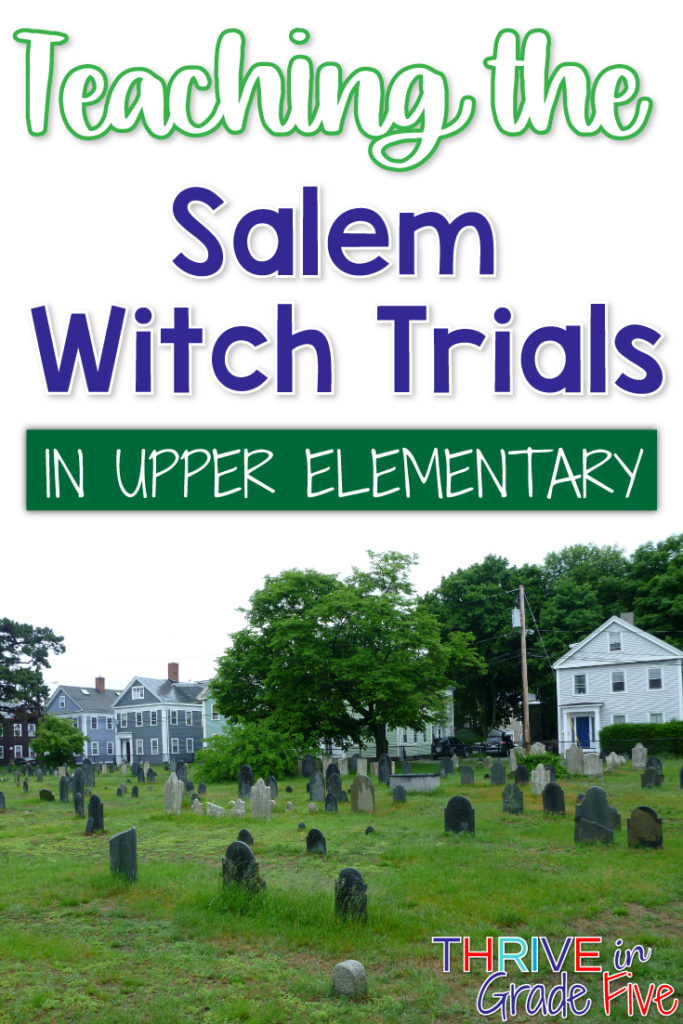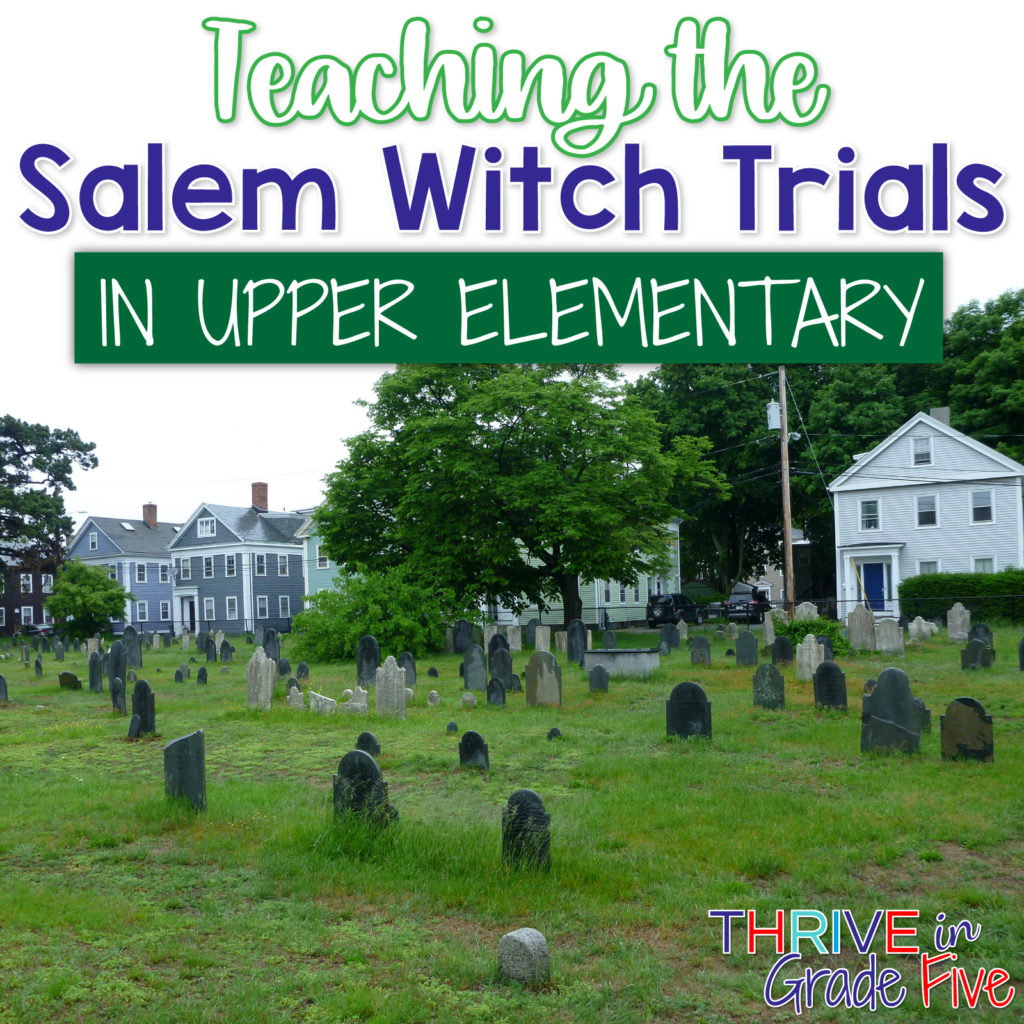The 17th Century Salem Witch Trials are not in my state’s curriculum. However, I have found that teaching about this unfortunate time gives students insight into the strict, oppressive beliefs of the Puritans.
Most people are aware of the Salem Witch Trials that took place in Massachusetts from 1692 to 1693. We’ve all heard the stories of the numerous people accused of witchcraft.
Although many men, women, and children were suspected of witchcraft, we know that there was nothing evil going on.
Everyone watched their neighbors and acquaintances with suspicion. Even small actions could lead to an accusation of witchery.
Why was this happening? What caused friends and neighbors to turn on one another?
Inexplicable things were happening in Salem. There were illnesses and deaths, loss of livestock, strange afflictions, and etc.
There had been prior witchcraft cases in New England, so it wasn’t surprising that worried citizens leapt to the conclusion of witchcraft.
The Beginnings of Hysteria
So, how did this terrifying time in history begin?
Two young cousins, Elizabeth Parris and Abigail Williams, began to demonstrate strange symptoms, including shaking, screaming, and odd movements. Their local doctor was no help. He diagnosed the girls with bewitchment.
Tituba, a woman enslaved to the Parris family, and two other women were accused of tormenting the girls. During the court hearing, the girls started screaming and moving their bodies in odd ways.
Tituba, in an attempt to avoid execution, confessed to witchcraft. The other two women continued to deny their involvement in witchery.
Ultimately, Tituba’s confession did save her life. She was placed in prison and avoided the noose.
Tituba “confessed” that there were more witches in Salem.
It is important to note that Tituba later recanted her confession and said that she was not a witch, that the other two women were not witches, nor were there any witches in Salem.
It was discovered later on that the girls’ behaviors were probably due to a fungus that was found in rye, wheat, and other cereals. This fungus can cause vomiting, muscle spasms, and delusions.
The Witch Trials
When Tituba stated that there were other witches in Salem, the colonists began to speculate about the identities of the other witches.
Unfortunately, Tituba’s false confession led to many other men, women, and children being accused of witchery.
In 1692, court cases were initiated to hear and decide on the guilt or innocence of the accused.
It took very little for a person to find his/her life at the mercy of the court. One individual or a small group could report suspicions to officials and the accused person would be brought to court.
The Salem Witch Trials came to an end on October 29, 1693 when the courts were dissolved. Every person accused of witchery was pardoned.
Spotlight on Three Witch Trial Victims
The three victims you are about to meet were innocent. However, their lives were changed abruptly due to the suspicion of witchcraft. Roger Toothaker, Bridget Bishop, and Esther Ewell were all accused of witchcraft and had different experiences.
Roger Toothaker
Roger Toothaker moved from London to Billerica, Massachusetts. He was a farmer and served as a medical apprentice to a Salem doctor known for using folk remedies.
Toothaker moved his family to Salem so that he could start his own medical practice. Court documents do not explain the charges against him, but in a document dated prior to the accusation, Thomas Gage said that Dr. Toothaker saw two children who were ill and exhibiting “unwanted fits.”
Dr. Toothaker, according to Thomas Gage, told him that he didn’t need to see the children again because his daughter killed the witch that caused this illness to the children. There was no evidence of this, only hearsay.
Unfortunately, Toothaker died in jail and never received his day in court.
Bridget Bishop
Bridget was certainly an interesting character. She owned and operated two profitable taverns, dressed in an “exotic manner,” partied late into the night, and fought in public with her husband.
Bridget seemed to rub Puritan leaders the wrong way with her “flamboyant” lifestyle. Abnormal fashion choices were considered a sign of the devil.
She was arrested and brought to court in 1692 after multiple people had accused her of witchcraft.
Bridget denied being a witch but there were an overwhelming number of accusers, including her brother-in-law. Bridget’s trial and execution occurred within a span of eight days.
Bridget was the first accused witch executed in Salem. Primary source documents report that Bridget continued to proclaim her innocence up to the moment of her execution.
Esther Ewell
The final individual I’d like you to meet is Esther Ewell. You may have heard her name in Season 1 of “Who Do You Think You Are?” During this episode, Sarah Jessica Parker set out to learn more about her ancestors and family tree.
During her research, Parker learned of Esther Ewell, her tenth great-grandmother. There was a warrant for Esther’s arrest in 1691. A woman named Betty Hubbard reported that she saw Esther committing witchcraft by pressing, squeezing, and then killing her neighbor.
Esther Ewell went to court but was not executed.
During this episode, Sarah Jessica Parker made the comment that the accused had the cards stacked against them. Her ancestor was one of the lucky ones who lived to tell about it.
Teaching About the Salem Witch Trials
As an educator, it is important to inform students that the Salem Witch Trials were not based on witchcraft. The trials were a misguided effort to explain things they couldn’t understand.
Unfortunately, many died because of the hysteria.
Listed below are several activities you can use with your students to give them a better understanding of the impact of the Salem Witch Trials:
● Discuss the beliefs that the Puritans had prior to coming to the New England Colonies.
● Explain how and why individuals were accused of witchcraft.
● Ask students to research an accused witch. They can find out what the colonist was accused of, the reason behind it, the court case itself, and the end result. The History of Massachusetts website is an excellent source of information.
● Ask students to discuss and write about the effects of rumors and hysteria both in 17th Century Salem and in our world today.
Need engaging, ready-to-use tomorrow Google Slides that teach the Salem Witch Trials? I’ve got you covered:

This History Snip-It will provide students an engaging overview of the Salem Witch Trials! Click on the image below to view the resource 🙂










2 Comments
Wow, I bought this off TPT and I can’t wait to use it with my homeschool co-op class. I’m pairing it with Shirley’s Jackson’s The Witchcraft of Salem Village. Thank you for all your hard work! I am grateful to benefit from it! =)
You are very welcome, Robin! I’m so glad you are enjoying my resource 🙂